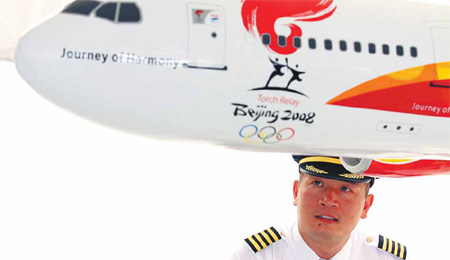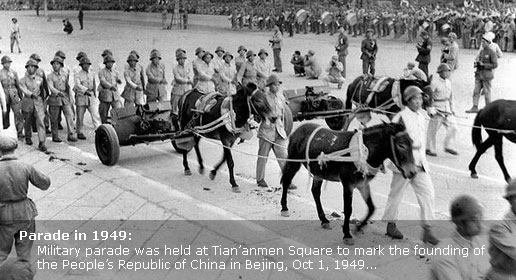60 People, 60 Stories
New heights
By Xin Dingding (China Daily)
Updated: 2009-09-30 07:41
|
 Commercial pilot Li Jun says the sector has seen a great deal of progress in management. [China Daily/Jiang Dong] |
Pilot Li Jun once flew a plane that lost the use of its on-board navigation system 10 minutes after takeoff.
"We had no directions on how to fly from Beijing to Haikou in Hainan province," he says.
"More than 100 passengers were on board. The plane could have got lost and ended up hundreds of miles away from the preset destination."
| ||||
"We had to make some small adjustments from time to time, according to the positions of other planes passing by," Li says.
The plane finally made its way to its destination. That was during Li's fourth year at Air China, in 1992.
"Though the trip took much longer than the scheduled three and a half hours, no passenger complained about the delay, though most of them were of the social elite or wealthy," he says.
At that time, traveling by air was considered something extravagant. Only those with social status or money traveled by air. Before that, even money could not secure an air ticket, because passengers had to have permission from their employers to buy air tickets, he says.
Li recalls the "absolute power" a captain had over these important guests on the plane at that time.
"When they were on board, they all had to listen to the captain. The captain was the one in charge of safety and therefore, the boss of the plane," he says.
"China was turning from a planned economy to a market-oriented one then. In a planned economy, demand exceeds supply. People had never enjoyed services and had no idea what it was."
"Passengers then already felt very satisfied, and even flattered, when the air hostesses provided them food and beverages with a smile," he says.
"They weren't as tough to serve as passengers now. Nor did they care much about punctuality."
Of course, the underdevelopment of civil aviation, symbolized by a small fleet and a few flights, meant planes did not have to line up at airports for takeoff orders as they do now, he says.
Air China, the national flag carrier and the largest domestic airline, then owned only seven Boeing 737 passenger planes and a few Boeing 747 cargo planes.
"When we got to an airport, it was always empty and only one or two planes shared berth," he says.
Air China now imports more than 20 planes a year.
Air travel has become a major travel means for Chinese people, along with railway and bus trips.
"The holidays, such as Spring Festival, used to be our holidays too. But now, holidays are always the busiest time of year," he says.
Looking at the dense web of air routes nowadays, many might think pilots are becoming more tired. Li disagrees.
China's civil aviation industry has been making progress not only in fleet size, but also in its management.
Two decades ago, no regulations stipulated the time for pilots' rest.
One of his colleagues even worked 17 days consecutively without taking a rest. Such intensity of work can make the pilot too tired and endanger flight safety, he says.
Laws and regulations were adopted a few years ago to ban the practice of assigning pilots to work more than eight hours a day and over 100 hours a month.
"It's a big step forward," Li says.
Time Line
Dec 2, 1949
The Civil Aviation Bureau is formed and subject to the supervision of the air force. By the next year, it owned some 30 small planes and transported 10,000 passengers a year.
1980
The Civil Aviation Bureau is split from the air force in March as an organization under the State Council to become a government department managing air transport operations.
1987
Reform to separate airlines from the civil aviation administration rolled out, with six State-owned airlines and six airport companies set up.
2002
Some 90 airports are transferred to local governments for management, except for the Beijing Capital International Airport and airports in the Tibet autonomous region.
2008
China maintains a fleet of 1,191 passenger planes and 68 cargo planes. Some 406 million passengers traveled by air, with 4.08 million tons of cargo and mail flown. China's civil aviation industry has experienced an annual growth rate of nearly 20 percent in the past 30 years.








